St. Paul's Chapel
St. Paul's Chapel is a chapel building of Trinity Church, an episcopal parish, located at 209 Broadway, between Fulton Street and Vesey Street, in Lower Manhattan, New York City. Built in 1766, it is the oldest surviving church building in Manhattan,[3] and one of the nation's finest examples of Late Georgian church architecture.[4]
St. Paul's Chapel | |
 | |

| |
| Location | Manhattan, New York City |
|---|---|
| Coordinates | 40°42′41″N 74°0′36″W |
| Built | 1766 |
| Architect | Thomas McBean |
| Architectural style | Georgian |
| NRHP reference No. | 66000551 |
| NYCL No. | 0075 |
| Significant dates | |
| Added to NRHP | October 15, 1966[1] |
| Designated NHL | October 9, 1960[2] |
| Designated NYCL | August 16, 1966 |
In 1960, the chapel was named a National Historic Landmark; it was also made a New York City Landmark and placed on the National Register of Historic Places in 1966. When St. Paul's Chapel remained standing after the September 11, 2001, attacks and the collapse of the World Trade Center behind it, the chapel was subsequently nicknamed "The Little Chapel That Stood".
Architecture
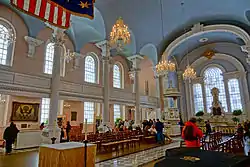
A chapel of the Parish of Trinity Church, St. Paul's was built on land granted by Anne, Queen of Great Britain, designed by architect Thomas McBean and built by master craftsman Andrew Gautier. Upon completion in 1766, it was the tallest building in New York City. It stood in a field some distance from the growing port city to the south and was built as a "chapel-of-ease" for parishioners who thought the mother church inconvenient to access.
Built of Manhattan mica-schist with brownstone quoins, St. Paul's has the classical portico, boxy proportions and domestic details that are characteristic of Georgian churches such as James Gibbs' London church of St Martin-in-the-Fields, after which it was modelled. Its octagonal tower rises from a square base and is topped by a replica of the Choragic Monument of Lysicrates (c. 335 BC).
Inside, the chapel's simple elegant hall has the pale colors, flat ceiling and cut glass chandeliers reminiscent of contemporary domestic interiors.
On the Broadway side of the chapel's exterior is an oak statue of the church's namesake, Saint Paul, carved by an unknown sculptor and installed in 1790.[5] Below the east window is the monument to Brigadier General Richard Montgomery, who died at the Battle of Quebec (1775) during the American Revolutionary War. In the spire, the first bell is inscribed "Mears London, Fecit [Made] 1797." The second bell, made in 1866, was added in celebration of the chapel's 100th anniversary.
History
Early history
The Hearts of Oak, a militia unit organized early in the American Revolutionary War, and composed in part of King's College (later, Columbia University) students, would drill in the Chapel's yard before classes nearby. Alexander Hamilton was an officer of this unit. The chapel survived the Great New York City Fire of 1776 when a quarter of New York City (then confined to the lower tip of Manhattan), including Trinity Church, burned following the British capture of the city after the Battle of Long Island during the American Revolutionary War.
George Washington, along with members of the United States Congress, worshipped at St. Paul's Chapel on his Inauguration Day, April 30, 1789.[6] Washington also attended services at St. Paul's during the two years New York City was the country's capital. Above Washington's pew is an 18th-century oil painting of the Great Seal of the United States, adopted in 1782.
The chapel contains several monuments and memorials that attest to its elevated status in early New York: a monument to Richard Montgomery (hero of the battle of Quebec) sculpted by Jean-Jacques Caffieri (1777), George Washington's original pew and a Neo-Baroque sculpture called "Glory" designed by Pierre L'Enfant, the designer of Washington, D.C. The pulpit is surmounted by a coronet and six feathers, and fourteen original cut-glass chandeliers hang in the nave and the galleries.

September 11, 2001 attacks
The rear of St. Paul's Chapel faces Church Street, opposite the east side of the World Trade Center site. After the attacks on September 11, 2001, which led to the collapse of the twin towers of the World Trade Center, St. Paul's Chapel served as a place of rest and refuge for recovery workers at the WTC site.
For eight months, hundreds of volunteers worked 12-hour shifts around the clock, serving meals, making beds, counseling and praying with fire fighters, construction workers, police and others. Massage therapists, chiropractors, podiatrists and musicians also tended to their needs.
The church survived without even a broken window. Church history declares it was spared by a miracle sycamore on the northwest corner of the property that was hit by debris. The tree's root has been preserved in a bronze memorial by sculptor Steve Tobin. While the church's organ was badly damaged by smoke and dirt, the organ has been refurbished and is in use again.[7]

The fence around the church grounds became the main spot for visitors to place impromptu memorials to the event. After it became filled with flowers, photos, teddy bears, and other paraphernalia, chapel officials decided to erect a number of panels on which visitors could add to the memorial. Estimating that only 15 would be needed in total, they eventually required 400.
Rudy Giuliani gave his mayoral farewell speech at the church on December 27, 2001.
The Chapel is now a popular tourist destination since it still keeps many of the memorial banners around the sanctuary and has an extensive audio video history of the event. There are a number of exhibits in the Chapel. The first one when entering is "Healing Hearts and Minds", which consists of a policeman's uniform covered with police and firefighter patches sent from all over the country, including Iowa, West Virginia, California, etc. The most visible is the "Thread Project", which consists of several banners, each of a different color, and woven from different locations from around the globe, hung from the upper level over the pews.
Renovations
A comprehensive restoration of the building's exterior was begun in 2013. At the façade, rusticated blocks of Manhattan schist and smooth sandstone accents were restored, repaired, or patched. The steeple clock was fitted with a new digital system, its bells maintained, and the clock faces refurbished. Some of the original clockwork elements were set aside for preservation as artifacts. Cornices were treated with a sand-infused paint, in the tradition of the original coatings, and broken panes in the wood windows were replaced with crafted glass that displays the imperfections found in antique glass. SUPERSTRUCTURES Engineers + Architects oversaw the investigation, design and construction project.
Concurrently the parish undertook a restoration of its churchyard. The churchyard has long been a pastoral oasis in busy lower Manhattan, but decades of damage and the sharp rise in tourism necessitated a revitalization. Conditions such as soil erosion and compaction, poor irrigation, and overgrown trees were addressed. The sensitive site, which includes human remains, fragile stone grave markers, and mature tree roots, was treated at the surface level, with all work done by hand. Mathews Nielsen Landscape Architects with Liz Farrell Landscape Architecture oversaw the improvements.
Services

St. Paul's Chapel is a very active part of the Parish of Trinity Church, holding services, weekday concerts, occasional lectures, and providing a shelter for the homeless.
On the evening of September 10, 2006, St. Paul's Chapel hosted a memorial service that was attended by President George W. Bush, Senator Hillary Clinton, Governor George Pataki, and Mayors Michael Bloomberg and Rudy Giuliani,[8] with the chapel holding additional services on the fifth anniversary of the September 11, 2001 attacks.
The chapel has hosted many famous worshippers. George Washington worshiped here on his Inauguration Day, April 30, 1789. During the two years New York City was the country's capital, Washington attended services at St. Paul's while Trinity Church was being rebuilt. Hanging above Washington's pew is a painting of the Great Seal of the United States (adopted in 1782), which was commissioned by the Vestry in 1785. The artist of the painting is unknown.
Directly across the chapel from Washington's pew is the Governor's pew, which Governor George Clinton, the first Governor of the State of New York, used when he visited St. Paul's, is marked by The Arms of the State of New York to commemorate his service. Other historical worshipers have included Prince William, later William IV of the United Kingdom, Lord Cornwallis, Sir William Howe, Commander-in-Chief of British forces in America and several U.S. Presidents: Grover Cleveland, Benjamin Harrison, and George H. W. Bush.
Burials
- Richard Montgomery and his wife Janet Livingston Montgomery
- Richard Coote, 1st Earl of Bellomont
- William Denning
- John Holt, publisher
- William Houstoun, lawyer
- Campbell P. White and wife Harriet Banyer Le Roy White
- Stephen Rochefontaine
Landmark designations
The building was declared a National Historic Landmark in 1960,[2][9][10] in part because it is the oldest public building in continuous use in New York City. It was made a New York City designated landmark in 1966.[11]
In 2016 the New York Landmarks Conservancy recognized both the Chapel and churchyard restoration projects with its Lucy G. Moses Preservation Award.
Gallery
 Monument to Richard Montgomery, above his tomb
Monument to Richard Montgomery, above his tomb "Healing Hearts and Minds", an exhibit inside the chapel, consisting of a red chasuble covered with police and firefighter patches sent from all over the world. A British Bobby's helmet is on top
"Healing Hearts and Minds", an exhibit inside the chapel, consisting of a red chasuble covered with police and firefighter patches sent from all over the world. A British Bobby's helmet is on top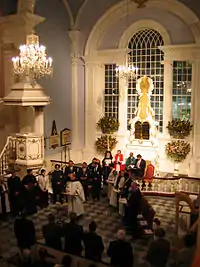 Interfaith service at St. Paul's Chapel on September 11, 2006
Interfaith service at St. Paul's Chapel on September 11, 2006_(14593309848).jpg.webp) From the south, across Broadway
From the south, across Broadway
See also
References
Notes
- "National Register Information System". National Register of Historic Places. National Park Service. March 15, 2006.
- "St. Paul's Chapel". National Historic Landmark summary listing. National Park Service. 2007-09-11. Archived from the original on 2014-04-13.
- Nevius, Michelle & Nevius, James (2009), Inside the Apple: A Streetwise History of New York City, New York: Free Press, p. 108, ISBN 141658997X
- "NHL nomination for St. Paul's Chapel". National Park Service. Retrieved 2018-01-04.
- Andy Mai & Denis Slattery, "St. Paul statue returns to old Manhattan chapel," The New York Daily News, October 5, 2016.
- Davidson, Roger H., Walter J. Oleszek (2006). Congress and Its Members. CQ Press. p. 13.CS1 maint: multiple names: authors list (link)
- "Church organ from St. Paul's Chapel - damaged in 9/11 attacks - returned in time for Easter". New York Daily News. April 9, 2009.
- "St. Paul's and the Three Georges". St. Paul's Chapel. September 10, 2006. Archived from the original on December 2, 2006.
- Heintzelman, Patricia (October 11, 1975). "National Register of Historic Places Inventory-Nomination: St. Paul's Chapel" (pdf). National Park Service.
- "National Register of Historic Places Inventory-Nomination: St. Paul's Chapel—Accompanying photos" (pdf). National Park Service. 1975.
- "Saint Paul's Chapel and Graveyard" (PDF). New York City Landmarks Preservation Commission. 1966-08-16. Retrieved July 17, 2020.
External links
| Wikimedia Commons has media related to St. Paul's Chapel. |
- The Parish of Trinity Church – Official website
- The records of St. Paul's Chapel – at Trinity Wall Street Archives
- Search St. Paul's Chapel burial records at Trinity Wall Street Archives
- The Cathedral Church of Saint John the Divine – Mother Church of the Episcopal Diocese of New York
- Saint Paul's Tombstone & Churchyard Gallery
- National Historic Register Number: 66000551
- St. Paul's Chapel, Wall Street, New York City listing on National Park Service Register.
- 2016 Lucy G. Moses Awards Program PDF
- Trinity Church Blog

